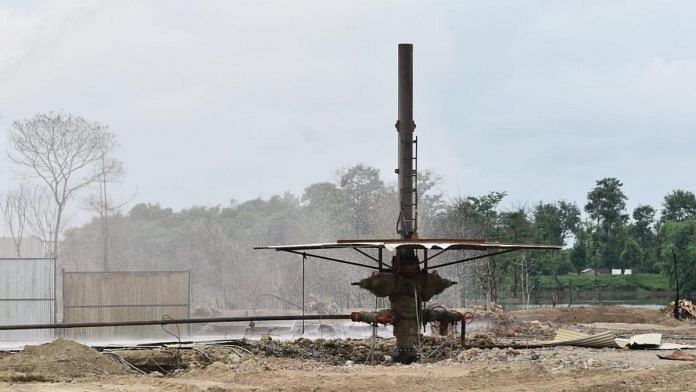Guwahati: The Oil India Limited (OIL) has successfully diverted the uncontrolled release of natural gas from a well in Assam’s Baghjan area to nearby flare pits, managing to tame a fire that has been burning for over three months now.
The diversion, which took place Sunday, came over 100 days after the natural gas well suffered a blowout — an uncontrolled release of gas/oil — on 27 May and a subsequent fire at the wellhead area on 9 June.
OIL spokesperson Tridib Hazarika told ThePrint that an announcement will be made in the next two days on the procedure for the ‘well-killing‘ operation, which might take another three-four weeks.
“The well is still not controlled. We have stopped the gas from releasing vertically and there is no monstrous fire like before. Dousing the flame is not the problem, but the issue is to control the outflow of gas from the wellhead,” he said.
“Actually, we did not do anything to douse the fire. We tried to stop the gas from coming out vertically and diverted it to other areas through pipelines. Now, partial gas is going to our production centre and some is being burnt,” Hazarika said.
The blowout had taken place at well no. 5 in Baghjan after pressure-control systems failed during workover operations to produce gas from a reservoir at 3,729 metres.
While the periphery fire, resulting from the gas and condensate, spread to over 500-600 metre and was controlled within 24 hours, the fire that occurred on 9 June has been raging ever since at the wellhead.
Authorities have since been trying to contain the uncontrolled release of gas from the wellhead area.
“We have been able to join pipelines to the blowout preventer (BOP), and through the BOP, we have been able to divert the gas. We have done this to reduce the pressure at the blowout well,” Hazarika explained, adding that the successful diversion has resulted in a fall in pressure at the wellhead from 4,200 PSI (pound per square inch) to 2,000 PSI.
Also read: What happened in Assam’s Baghjan — doctor who worked at Oil India for 30 yrs breaks it down
Two failed attempts
OIL had earlier made two unsuccessful attempts to install the BOP before finally succeeding the third time on 17 August. A well-killing operation was also initiated before which failed to yield result.
On 7 September, OIL authorities reported a leak at the wellhead after a near successful diversion that lasted eight hours. It took around six days, until Sunday, to repair this leakage, following which the experts had resumed the process of diverting the gas.
“We failed to kill the well in the first attempt because of the kind of pressure in it. We noticed certain defects in the wellhead, and so we contemplated that it was difficult to kill it using traditional methods. Our experts then derived the idea to generally reduce the pressure in the wellhead by diverting the gas,” Hazarika said.
An electrical engineer with OIL died of electrocution on 9 September while testing a wire connected to a generator meant to supply power for welding purposes. Earlier, on 10 June, bodies of two firefighters, who died battling the massive blaze at the oil well site, were recovered from a water body nearby.
Six foreign experts from Singapore-based firm Alert Disaster Control have been working alongside professionals from the Oil and Natural Gas Corporation (ONGC) and other agencies. OIL has been dishing out more than Rs 30 lakh every day for various expenses of the foreign experts.
Also read: Assam’s oil well leak failed to create viral visuals like Vizag gas leak did
600 families waiting to return home
The district administration and OIL authorities, meanwhile, are also assessing the impact of the diversion to enable local residents who were moved from nearby areas of the gas well site to relief camps to return home.
Bhaskar Pegu, Deputy Commissioner of Tinsukia district where Baghjan is located, said “those living in the two relief camps might return home now, if they want”. A final assessment of the prevailing situation can be done after 72-hour of observation and once the entire diversion exercise is stabilised, he added.
About 600 families are currently living in two relief camps — while some are lodged at the Baghjan relief camp, situated 1.5 km from the gas well site, others are in the Natungaon camp, 2.6 km away.
OIL authorities said tremors in and around the site as well as noise level have also come down.
“They have diverted the fire to another area where we can still see it burning. The noise levels have come down considerably though,” said Chiranjit Moran, a local resident in Baghjan.
In the past several weeks, protests by villagers at drilling and workover locations of OIL have severely impacted oil and natural gas production. Operations have been disrupted in 13 OIL and 5 natural wells in the vicinity of Baghjan.
An environmental impact assessment was done prior to the capping of the well, and another study is set to be completed at the end of operations. A recording is also being done for seismological study near the gas well site, while a team from The Energy and Research Institute (TERI) has started sample collection for air quality and noise level management.
The National Green Tribunal, meanwhile, has formed a committee of eight experts to assess the damage caused to local residents and the ecosystem due to the blowout.
Also read: 2 Oil India staffers suspended for negligence in Assam gas well blowout



